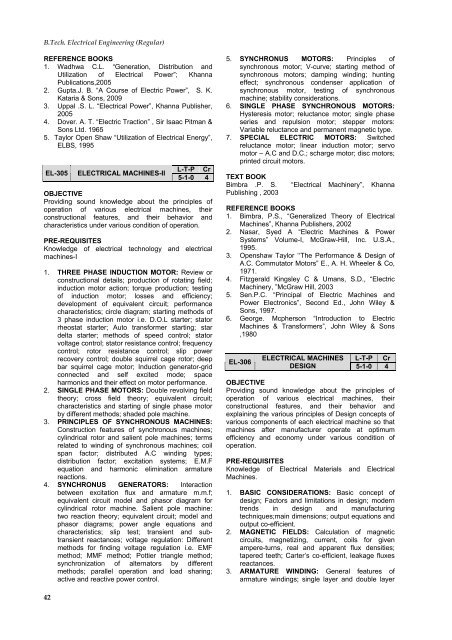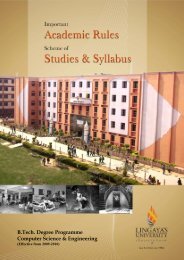B.<strong>Tech</strong>. <strong>Electrical</strong> <strong>Engineering</strong> (Regular)REFERENCE BOOKS1. Wadhwa C.L. “Generation, Distribution andUtilization of <strong>Electrical</strong> Power”; KhannaPublications,20052. Gupta.J. B. “A Course of Electric Power”, S. K.Kataria & Sons, 20093. Uppal .S. L. “<strong>Electrical</strong> Power”, Khanna Publisher,20054. Dover. A. T. “Electric Traction” , Sir Isaac Pitman &Sons Ltd. 19655. Taylor Open Shaw “Utilization of <strong>Electrical</strong> Energy”,ELBS, 1995EL-305ELECTRICAL MACHINES-IIL-T-P Cr5-1-0 4OBJECTIVEProviding sound knowledge about the principles ofoperation of various electrical machines, theirconstructional features, and their behavior andcharacteristics under various condition of operation.PRE-REQUISITESKnowledge of electrical technology and electricalmachines-I1. THREE PHASE INDUCTION MOTOR: Review orconstructional details; production of rotating field;induction motor action; torque production; testingof induction motor; losses and efficiency;development of equivalent circuit; performancecharacteristics; circle diagram; starting methods of3 phase induction motor i.e. D.O.L starter; statorrheostat starter; Auto transformer starting; stardelta starter; methods of speed control; statorvoltage control; stator resistance control; frequencycontrol; rotor resistance control; slip powerrecovery control; double squirrel cage rotor; deepbar squirrel cage motor; Induction generator-gridconnected and self excited mode; spaceharmonics and their effect on motor performance.2. SINGLE PHASE MOTORS: Double revolving fieldtheory; cross field theory; equivalent circuit;characteristics and starting of single phase motorby different methods; shaded pole machine.3. PRINCIPLES OF SYNCHRONOUS MACHINES:Construction features of synchronous machines;cylindrical rotor and salient pole machines; termsrelated to winding of synchronous machines; coilspan factor; distributed A.C winding types;distribution factor; excitation systems; E.M.Fequation and harmonic elimination armaturereactions.4. SYNCHRONUS GENERATORS: Interactionbetween excitation flux and armature m.m.f;equivalent circuit model and phasor diagram forcylindrical rotor machine. Salient pole machine:two reaction theory; equivalent circuit; model andphasor diagrams; power angle equations andcharacteristics; slip test; transient and subtransientreactances; voltage regulation: Differentmethods for finding voltage regulation i.e. EMFmethod; MMF method; Pottier triangle method;synchronization of alternators by differentmethods; parallel operation and load sharing;active and reactive power control.5. SYNCHRONUS MOTORS: Principles ofsynchronous motor; V-curve; starting method ofsynchronous motors; damping winding; huntingeffect; synchronous condenser application ofsynchronous motor, testing of synchronousmachine; stability considerations.6. SINGLE PHASE SYNCHRONOUS MOTORS:Hysteresis motor; reluctance motor; single phaseseries and repulsion motor; stepper motors:Variable reluctance and permanent magnetic type.7. SPECIAL ELECTRIC MOTORS: Switchedreluctance motor; linear induction motor; servomotor – A.C and D.C.; scharge motor; disc motors;printed circuit motors.TEXT BOOKBimbra .P. S. “<strong>Electrical</strong> Machinery”, KhannaPublishing , 2003REFERENCE BOOKS1. Bimbra, P.S., “Generalized Theory of <strong>Electrical</strong>Machines”, Khanna Publishers, 20022. Nasar, Syed A “Electric Machines & PowerSystems” Volume-I, McGraw-Hill, Inc. U.S.A.,1995.3. Openshaw Taylor ‘‘The Performance & Design ofA.C. Commutator Motors” E., A. H. Wheeler & Co,1971.4. Fitzgerald Kingsley C & Umans, S.D., “ElectricMachinery, ”McGraw Hill, 20035. Sen.P.C. “Principal of Electric Machines andPower Electronics”, Second Ed., John Wiley &Sons, 1997.6. George. Mcpherson “Introduction to ElectricMachines & Transformers”, John Wiley & Sons,1980EL-306ELECTRICAL MACHINES L-T-P CrDESIGN 5-1-0 4OBJECTIVEProviding sound knowledge about the principles ofoperation of various electrical machines, theirconstructional features, and their behavior andexplaining the various principles of Design concepts ofvarious components of each electrical machine so thatmachines after manufacturer operate at optimumefficiency and economy under various condition ofoperation.PRE-REQUISITESKnowledge of <strong>Electrical</strong> Materials and <strong>Electrical</strong>Machines.1. BASIC CONSIDERATIONS: Basic concept ofdesign; Factors and limitations in design; moderntrends in design and manufacturingtechniques;main dimensions; output equations andoutput co-efficient.2. MAGNETIC FIELDS: Calculation of magneticcircuits, magnetizing, current, coils for givenampere-turns, real and apparent flux densities;tapered teeth; Carter’s co-efficient, leakage fluxesreactances.3. ARMATURE WINDING: General features ofarmature windings; single layer and double layer42
Lingaya’s University, Faridabadand commutator windings; integral and fractionalslot windings; winding factor;Classification ofinsulating materials.4. HEATING COOLING AND VENTILATION: Heatdissipation; heat flow; heating cooling curves;Heating cooling cycles; estimation of maximumtemperature rise; cooling media; Quantity ofcooling media; Types of enclosures; ratings; heatdissipation;Methods of ventilation.5. TRANSFORMER DESIGN: Output equation designof core; yoke and windings; overall dimensions;Computation of no load current to voltageregulation; efficiency and cooling system designs.6. DESIGN OF ROTATING MACHINES: Outputequations of rotating machines; specific electric andmagnetic loadings; factors affecting size of rotatingmachines; separation of main dimensions; selectionof frame size; Core and armature design of DC and3-phase ac machines Rotor design of three phaseinduction motors. Design of field system of DCmachine and synchronous machines; estimation ofperformance from design data7. COMPUTER AIDED DESIGN: Philosophy ofcomputer aided design; advantages andlimitations; Computer aided design approachesanalysis; synthesis and hybridmethods;Development of computer program andperformance prediction; Concept of optimizationtechniques and its general procedure.Flow charts and ‘c’ and ‘vb’ based computerprograms for the design of transformer; DCmachine; three phase induction and synchronousmachines. Study of electrical machine designsoftwares like Ansoft RMXPert, speed.TEXT BOOKSawhney.A. K. “A Course in <strong>Electrical</strong> MachineDesign”, Khanna Publication,. 2005REFERENCE BOOKS1. Mittle .V. N. “Design of <strong>Electrical</strong> Machines”Standard Publishers & Distributors, 20062. Say, M. G. “Theory, Performance and Design ofAlternating Current Machines” ELBS , 15 thEd.,19623. Clayton .AE, “Theory, Performance and Design ofDirect Current Machines” 3 rd Ed., 1967.4. Rao .S. S. “Optimization <strong>Tech</strong>nique”, 20005. Prasad K. Prakash Satya “Computer Aided<strong>Electrical</strong> Machine Design”, 1st Ed., 20061. AUTOMATIC GENERATION CONTROL: Loadfrequency control (single area case); loadfrequency control and economic dispatch; optimalload frequency control; load management.2. ECONOMIC LOAD DESPATCH: Introduction;Optimal Operation of Generators of Bus bar; UnitCommitment; Reliability Considerations; OptimalGeneration Schedule Hydro thermal optimalscheduling.3. POWER SYSTEM STABILITY: Steady state;transient and dynamic stabilities; equal areacriteria; effect of fault clearing time on transientstability; dynamics of synchronous machine;factors affecting transient stability.4. AUTOMATIC VOLTAGE CONTROL &EXCITATION SYSTEMS: AVRs; role of AVR ontransient stability of system; type 0 and 1 excitationsystem; power system stabilizers.5. VOLTAGE STABILITY: Basic concept; Voltagecollapse; modelling and prevention.6. ECONOMICS OPERATION OF POWERSYSTEMS: Distribution of Load between Unitswithin a Plant; Transmission Loss as a Function ofPlant Generation; Distribution of Load betweenPlants; A Method of Computing Penalty Factorsand Loss Coefficients; Automatic GenerationControl Problems7. POWER SYSTEM IMPROVEMENT: Introduction;Methods of power system Improvement; powersystem scheme; determination of voltageregulation and losses in power system shifting ofdistribution transformer centre. Financial asperts ofpower system improvement scheme.TEXT BOOKNagrath .I.J. and Kothari. D.P. “Power System<strong>Engineering</strong>”, Tata Mcgraw Hill,. 2006REFERENCE BOOKS1. E.W. Kimbark, “Power System Stability”, JohnWiley & Sons, 20012. P.Kundur, “Power System Control and Stability”,Tata McGraw Hill, 20063. B.R.Gupta, “Power System Analysis & Design”, S.Chand & Sons, 20084. S.Rao “EHV-AC/DC Transmission System”;Khanna Pulishers, 1999.5. William D. Stevenson, Jr., “Elements of PowerSystem Analysis”, Mc-Graw Hill International,Fourth Edition,1982EL-307POWER SYSTEM L-T-P CrOPERATION AND CONTROL 5-1-0 4EL-308MICROPROCESSOR AND L-T-P CrMICROCONTROLLER 5-0-0 3OBJECTIVEProviding sound knowledge about the variouscomponents of power system; Generation; distributionand transmission and explain the role and importanceof each; explaining the principles governing the efficientoperation of each component at optimum efficiency andvarious techniques for analyzing the stability of powersystem.PRE-REQUISITESKnowledge of electrical technology and electrical powersystems.OBJECTIVEProviding a sound understanding of the fundamentalconcepts of microprocessor and microcontrollers 8085,8086, explaining the various assembling levelprogramming and Interfacing devices techniques andData transfer techniques and their applications.PRE-REQUISITESKnowledge of basic electronics circuits.1. THE 8085 PROCESOSOR: Introduction tomicroprocessor; History and evolution; 808543
- Page 1 and 2: B.Tech. Degree ProgrammeElectrical
- Page 5 and 6: Lingaya’s University, FaridabadAB
- Page 7 and 8: IMPORTANT ACADEMIC RULESB.Tech. Deg
- Page 9 and 10: Lingaya’s University, Faridabadac
- Page 11 and 12: Lingaya’s University, FaridabadSe
- Page 13 and 14: Lingaya’s University, FaridabadIn
- Page 15 and 16: CATEGORY-WISE LIST OF COURSESLingay
- Page 17 and 18: Lingaya’s University, FaridabadSU
- Page 19 and 20: Lingaya’s University, FaridabadSc
- Page 22 and 23: B.Tech. Electrical Engineering (Reg
- Page 24 and 25: B.Tech. Electrical Engineering (Reg
- Page 26 and 27: B.Tech. Electrical Engineering (Reg
- Page 28 and 29: B.Tech. Electrical Engineering (Reg
- Page 30 and 31: B.Tech. Electrical Engineering (Reg
- Page 32 and 33: B.Tech. Electrical Engineering (Reg
- Page 34 and 35: B.Tech. Electrical Engineering (Reg
- Page 36 and 37: B.Tech. Electrical Engineering (Reg
- Page 38 and 39: B.Tech. Electrical Engineering (Reg
- Page 40 and 41: B.Tech. Electrical Engineering (Reg
- Page 42 and 43: B.Tech. Electrical Engineering (Reg
- Page 44 and 45: B.Tech. Electrical Engineering (Reg
- Page 48 and 49: B.Tech. Electrical Engineering (Reg
- Page 50 and 51: B.Tech. Electrical Engineering (Reg
- Page 52 and 53: B.Tech. Electrical Engineering (Reg
- Page 54 and 55: B.Tech. Electrical Engineering (Reg
- Page 56 and 57: B.Tech. Electrical Engineering (Reg
- Page 58 and 59: B.Tech. Electrical Engineering (Reg
- Page 60 and 61: B.Tech. Electrical Engineering (Reg
- Page 62 and 63: B.Tech. Electrical Engineering (Reg
- Page 64 and 65: B.Tech. Electrical Engineering (Reg
- Page 66 and 67: B.Tech. Electrical Engineering (Reg
- Page 68 and 69: B.Tech. Electrical Engineering (Reg
- Page 71 and 72: OPEN ELECTIVELingaya’s University
- Page 73 and 74: Lingaya’s University, Faridabadch
- Page 75 and 76: Lingaya’s University, Faridabad4
- Page 77 and 78: Lingaya’s University, Faridabad6.
- Page 79 and 80: Lingaya’s University, FaridabadEL
- Page 81 and 82: Lingaya’s University, Faridabad5
- Page 83 and 84: Lingaya’s University, Faridabador
- Page 85 and 86: Lingaya’s University, Faridabad4.
- Page 87: Lingaya’s University, Faridabad83
















